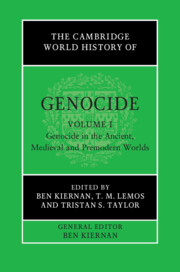Book contents
- The Cambridge World History of Genocide
- The Cambridge World History of Genocide
- The Cambridge World History of Genocide
- Copyright page
- Contents
- Figures
- Maps
- Tables
- Contributors to Volume I
- General Editor’s Acknowledgements
- General Editor’s Introduction to the Series
- Introduction to Volume I
- Part I Themes of Genocide through History
- Part II The Ancient World
- Part III The Medieval World and Early Imperial Expansions
- 15 William the Conqueror’s Harrying of the North, 1069–1070
- 16 Genocidal Massacres of Jews in Medieval Western Europe, 1096–1392
- 17 Crusaders and Mass Killing at Jerusalem in 1099
- 18 The Albigensian Crusade and the Early Inquisitions into Heretical Depravity, 1208–1246
- 19 Mongol Genocides of the Thirteenth Century
- 20 Việt Nam and the Genocide of Champa, 1470–1509
- 21 Genocidal Massacres in Medieval India
- 22 Mass Extermination in Prehistoric Andean South America
- 23 The Spanish Destruction of the Canary Islands
- 24 Genocidal Massacres in the Spanish Conquest of the Americas
- Index
23 - The Spanish Destruction of the Canary Islands
A Template for the Caribbean Genocide
from Part III - The Medieval World and Early Imperial Expansions
Published online by Cambridge University Press: 23 June 2023
- The Cambridge World History of Genocide
- The Cambridge World History of Genocide
- The Cambridge World History of Genocide
- Copyright page
- Contents
- Figures
- Maps
- Tables
- Contributors to Volume I
- General Editor’s Acknowledgements
- General Editor’s Introduction to the Series
- Introduction to Volume I
- Part I Themes of Genocide through History
- Part II The Ancient World
- Part III The Medieval World and Early Imperial Expansions
- 15 William the Conqueror’s Harrying of the North, 1069–1070
- 16 Genocidal Massacres of Jews in Medieval Western Europe, 1096–1392
- 17 Crusaders and Mass Killing at Jerusalem in 1099
- 18 The Albigensian Crusade and the Early Inquisitions into Heretical Depravity, 1208–1246
- 19 Mongol Genocides of the Thirteenth Century
- 20 Việt Nam and the Genocide of Champa, 1470–1509
- 21 Genocidal Massacres in Medieval India
- 22 Mass Extermination in Prehistoric Andean South America
- 23 The Spanish Destruction of the Canary Islands
- 24 Genocidal Massacres in the Spanish Conquest of the Americas
- Index
Summary
The European conquest of the seven islands of the Canarian archipelago lasted almost a century (1402-1496). It was carried mostly by private adventurers backed by the legal rights of the Castilian crown and supplied by private financiers, who expected a quick return. It brought the destruction of the native population of all its islands, the erasure of their names, language, custom, economy, land ownership, ecological environment, beliefs, culture, social structure, and political organization. The means by which it was achieved were enslavement, deportation, disease, and the strategic use of terror. Acculturation, miscegenation, and the building of a colonial society based on plantation agriculture and long-distance trade did the rest to erase any trace of the indigenous culture. Genocide, in the case of the Canary Islands, can be understood both as a process of attrition, following its use by Fein and Rosenberg, and as an outcome, the aggregate result of thousands of specific instances of violence. It also was a prelude, a necessary learning ground and a blueprint of the European conquest and settler colonialism in the Antilles begun in the 1490s. The American conquest proved a much faster application of the same template for genocide, over a vast territory.
Keywords
- Type
- Chapter
- Information
- The Cambridge World History of Genocide , pp. 594 - 621Publisher: Cambridge University PressPrint publication year: 2023



